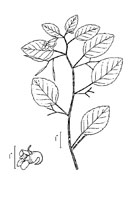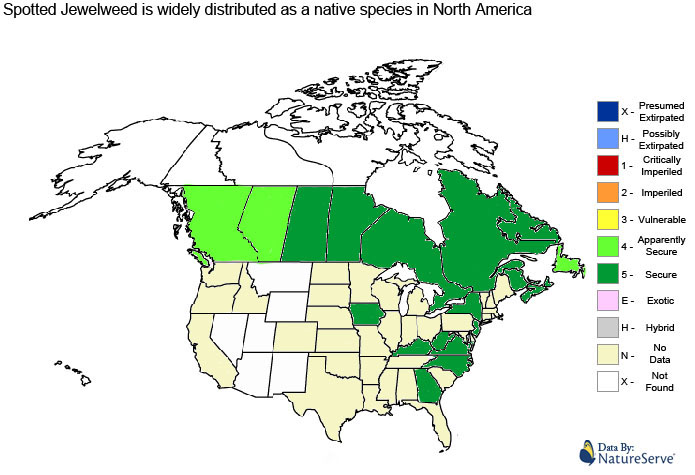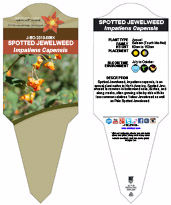

| Plant Name | Spotted Jewelweed | |
| Scientific Name | Impatiens Capensis | |
| Family | Balsam (Touch-Me-Not) | |
| Plant Type | Annual | |
| Start of Blooming Season | July | |
| End of Blooming Season | October |

| Soil Conditions | |
| Soil Moisture | |
| Sunlight | |
| Notes: |

Spotted jewelweed is an annual plate that grows 60cm to 150cm in height with 4cm to 9cm long alternate and thinly ovate leaves. The leaves appear to be silver or 'jewelled' when held underwater, which is possibly where the jewelweed name comes from.The flowers of spotted jewelweed are orange with a three-lobed corolla; one of the calyx lobes is coloured similarly to the corolla and forms a hooked conical spur at the back of the flower. Plants may also produce non-showy cleistogamous flowers, which do not require cross-pollination. Nectar spurs are tubular elongations of petals and sepals of certain flowers that usually contain nectar. Flowers of spotted jewelweed have these nectar spurs. Nectar spurs are thought to have played a role in plant-pollinator coevolution. Curvature angles of nectar spurs of spotted jewelweed are variable. This angle varies from 0 degrees to 270 degrees. The angle of the nectar spur is very important in the pollination of the flower and in determining the most efficient pollinator. Hummingbirds are the main pollinators. They remove more pollen per visit from flowers with curved nectar spurs than with perpendicular nectar spurs. Hummingbirds are not the only pollinators of spotted jewelweed. Bees play an important role in pollination as well. Due to hummingbirds and bees, the pollination of spotted jewelweed is very high.
Other than in the basic natural form, spotted jewelweed can be found in one distinct variety:

| Plant Height | 60cm to 150cm |
| Habitat | Moist Woods, shaded wetlands, shorelines |
| Leaves | alternate 4cm to 9cm long |
| Leaf Margin | Crenate |
| Leaf Venation | Pinnate |
| Stems | smooth stems |
| Flowering Season | July to October |
| Flower Type | Bilaterally Symmetrical |
| Flower Colour | Orange |
| Pollination | Bees, hummingbirds |
| Flower Gender | Flowers are hermaphrodite and the plants are self-fertile |
| Fruit | small seeds in a swollen capsule |
| USDA Zone | 4A (-31°C to -34°C) cold weather limit |

The following health hazards should be noted when handling or choosing a location to plant spotted jewelweed:
 |
POSSIBLE TOXICITY Spotted Jewelweed contains large amounts of calcium oxalate which can cause severe digestive upset, breathing difficulties, convulsions, coma, and possibly death if large enough quantities are consumed. |

 |
-Click here- or on the thumbnail image to see an artist rendering, from The United States Department of Agriculture, of spotted jewelweed. (This image will open in a new browser tab) |

 |
-Click here- or on the thumbnail image to see an artist rendering, from Prairie Moon Nursery, of the seeds created by spotted jewelweed for propagation. (This image will open in a new browser tab) |

Spotted jewelweed can be referenced in certain current and historical texts under the following four names: Spotted Jewelweed can be translated into the following select languages: |
|||||||||||||
| Arabic | Bulgarian | Chinese (Sim) | |||||||||||
| Croatian | Czech | Danish | |||||||||||
| Dutch | Esperanto | Estonian | |||||||||||
| Finnish | French | German | |||||||||||
| Greek | Hebrew | Hungarian | |||||||||||
| Italian | Japanese | スポッティング鳳仙花 | Korean | ||||||||||
| Punjabi | Lithuanian | Norwegian | |||||||||||
| Persian | گل حنا خال خال | Polish | Portuguese | ||||||||||
| Romanian | Russian | Slovak | |||||||||||
| Spanish | Swedish | Tagalog | |||||||||||
| Turkish | Ukrainian | Vietnamese | |||||||||||

| The information provided in this conservation assessment has been provided by the Natureserve Database in conjunction with various federal, provincial, state, county, district, regional, and municipal governments as well as public and private conservation authorities. Information in this section is accurate from the last time this article was updated. |
|
 |
Spotted jewelweed is considered to be a secure native species in North America. |

 |

 |
The MIROFOSS database offers free printable garden tags for personal and non-profit use. These tags can be used to properly identify plant samples in a garden. Click on the tags shown on the the screen or -click here- to download a full size jpeg image for a spotted jewelweed identification tag; which can be printed on paper or used with a plastic laser printer. |
 |
What's this? What can I do with it? |

| Description | Dickinson, T.; Metsger, D.; Bull, J.; & Dickinson, R. (2004) ROM Field Guide to Wildflowers of Ontario, Royal Ontario Museum, Toronto:McClelland and Stewart Ltd. |
| Description | Strausbaugh, P.D. & Core, E. L. (1964) Flora of West Virginia. 2nd ed. Seneca Books Inc., ISBN 0-89092-010-9 |
| Description | Travers, Steven E; Temeles, Ethan J; Pan, Irvin (2003). "The relationship between nectar spur curvature in jewelweed (Impatiens capensis) and pollen removal by hummingbird pollinators". Canadian Journal of Botany |
| Folklore | MacKinnon, Kershaw, Arnason, Owen, Karst, Hamersley, Chambers. 2009. Edible & Medicinal Plants Of Canada ISBN 978-1-55105-572-5 |
| Image Rendering | USDA-NRCS PLANTS Database / USDA NRCS. Wetland flora: Field office illustrated guide to plant species. USDA Natural Resources Conservation Service. |
| Environment | National Audubon Society. Field Guide To Wildflowers (Eastern Region): Alfred A. Knopf. ISBN 0-375-40232-2 |
| Physical Identification | National Audubon Society. Field Guide To Wildflowers (Eastern Region): Alfred A. Knopf. ISBN 0-375-40232-2 |
| September 02, 2015 | The last time this page was updated |
| ©2021 MIROFOSS™ Foundation | |
 |